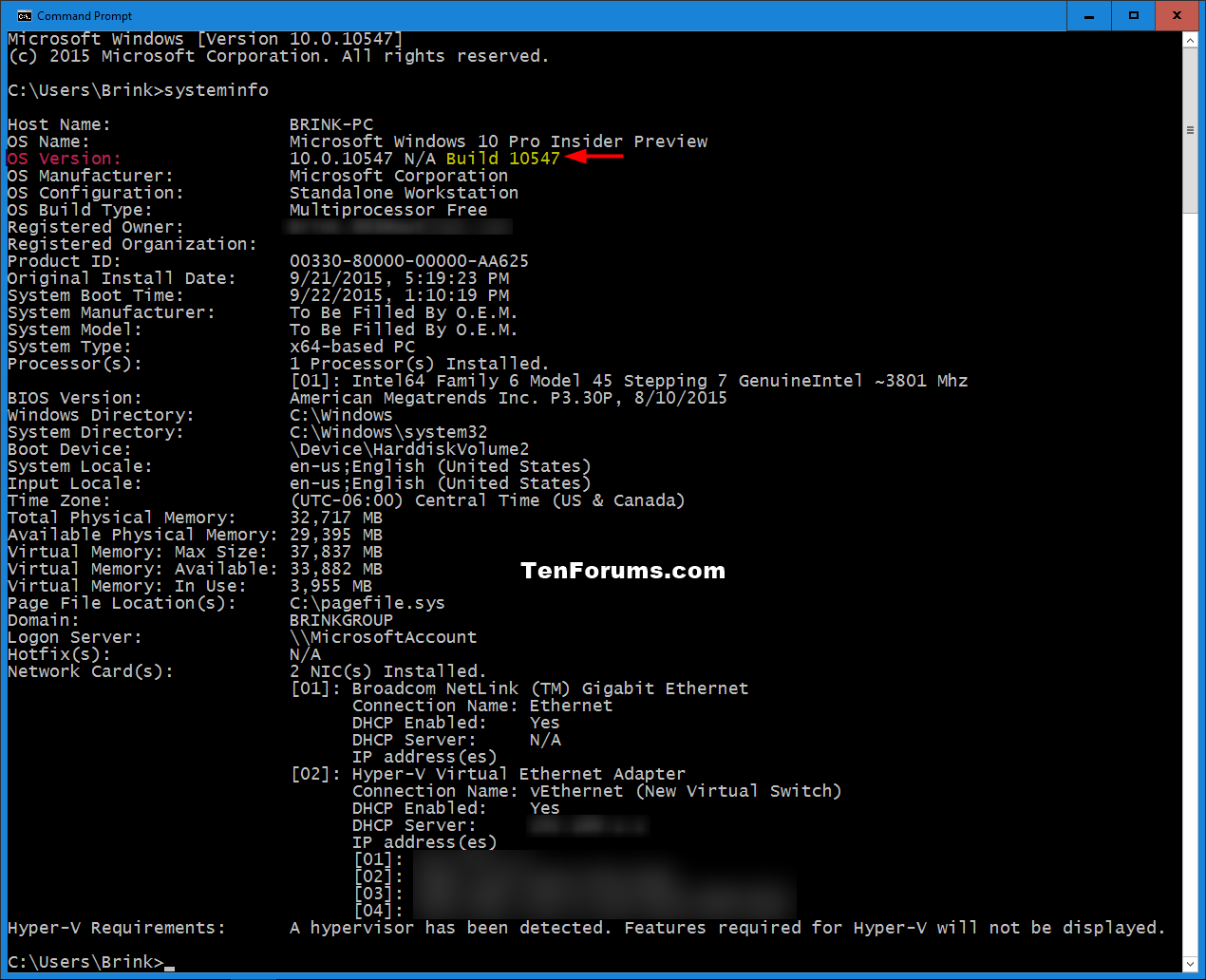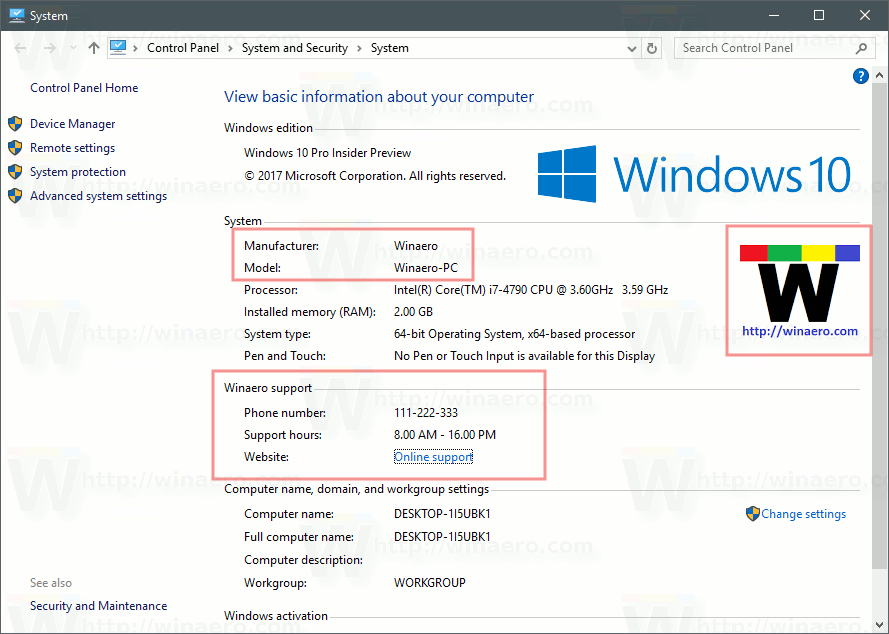Change Windows Oem Info
In terms of Windows software and usage, the OEM and retail Windows are identical. You get all the features as well as the unstoppable software updates. The OEM Windows has its product key tied to. First of all download the OEM Info Tool from the Downloads section. Extract the ZIP archive to any folder of your choice. OEM Info Tool comes separately both for 32-bit and 64-bit Windows operating systems. If you have 32-bit Windows, then double-click on OEMInfo32.exe. I have upgraded my laptop from Windows 7 Home to Windows 10 Home. I 'm trying to upgrade to Windows 10 Pro edition from usb installation files and not store. After running setup.exe and choosing Upgrade i reach in a screen as this but it says home instead of pro and i cannot change it anyway. I also tried putting ei.cfg in sources folder with. HKEYLOCALMACHINESOFTWAREMicrosoftWindowsCurrentVersionOEMInformation Note that older versions of Windows 10 don’t have an address bar. OEM Configurator is a portable application by AskVG that allows you to personalize the information in the Windows System Properties section. This eliminates the need of any kind of manual registry editing, and allows setting accurate naming resolution and associated settings according to a standard method.
There are many tweaking applications available today that can increase windows 7 productivity and easy of use i.e. application for tweaking logon screen, extending context menu, changing icons, easy access to windows services, optimize windows security options etc. But what if you get all these feature at the same place? Yes this is true with help of WinBubble.
WinBubble is a small and free application that provides lots of windows7 hidden tweaks and settings at the same place. All these tweaks are available category wise in different tabs from the menu. Categories in WinBubble are explained below.
General
Branding Your Computer: You can edit your system and owner information and change windows logo with any image you like, There is also an option to directly launch Windows OEM info and Owner info.
Add Features to Context Menu: With this option you will be able to add additions features like move to, copy to, take ownership , create restore point, restrict access to etc in your context menu. All these features can be enabled or disabled just by checking or un checking the corresponding boxes.
Desktop Customization: This enables additional desktop features like remove shortcut arrow, slow-down animations, hide empty drives, show username folder to desktop etc.
Specific
This tab provides you with the option to tweak default windows screen saver settings. You can tweak bubble, ribbon and mystify settings according to your choice.
Icons

This helps you to change default windows icons and replace them high resolution icons according to your wish, this change do not involve changing any system dll files and can be easily restored back easily.
Windows 7
Windows 7 welcome Screen Customization: You can change the default windows 7 welcome screen with any wallpaper present on your hard disk. You can also optimize the text present on welcome screen with shadow options. An unique option present in WinBubble is its integration with Ease of Access button present on the welcome screen, once this option is set you can press ease of access button on the welcome screen to access WinBubble before logging to windows. This gives you lots of options to tweak, customize and fix many issues.
Windows Utilities and Tools: It provides many utilities properly categorized under Online tools, useful tools, maintenance and advanced tools, network and other tools, DOS utilities and other tools.


Security
Securing Desktop: With this option you can enable/disable many security measures on your desktop. This include removing NEW option in context menu, remove folder option in windows menu, disable auto play of media devices, disable detection of usb media devices, disable writing to usb media devices, disable task manager, restrict access to control panel etc.
UAC Options: You can directly access UAC options from here and set its security level according to your choice. You can also enable password requirement to access UAC option.
Hide it: With this option you can hide all drives of your computer or select particular drives to be hidden. It also features hiding shutdown, sleep, hibernate and restart buttons.
Internet Explorer: This gives additional security controls to IE users. Features like disable new tab, disable open, disable view source, disable download, disable save as etc.
Optimize
Here you can optimize your system in terms of performance, it provides windows options to enable/disable windows visual effects, you also get options to disable windows Aero feature or windows components. This is specifically helpful for people with low system specification.
Start Menu Search: Allows changing start menu search options like searching file index, searching favorites and web pages and searching communication files.
Speed up: In this section you can enable/disable multiple monitor configuration, set menu display delay, decrease shut down time for services, increase bandwidth for internet and network connections, disable failed caching etc. You can also control startup programs from here.
Tools
It consists of options to add your custom applications to locations of your choice for better visibility and quick access. It should be better handled by advanced users.
Context Menu Customization Tool: In this section you can add any Right-Click Menu entries to your Computer icon, Internet Explorer, Explorer/Desktop, All Files in Windows Explorer, Disk, Network and Start Button/Folders easily.
My Computer and Control panel Items: You can add items and applications of your choice to my computer and control panel. You can put in items and tools in my computer section to find them easily.
My Tweaker Tool: It allows you to add your personalized tweaks to windows easily in a few steps.
More Policies
Desktop, taskbar and start menu: It provides lots of additional tweaks to taskbar and start menu like clear recent document history on exit, remove access to right click on taskbar, lock taskbar etc. For desktop there are options like hiding and disabling all items on desktop, disabling drag and drop, and restricting desktop toolbar adjustment. There are few quick settings that can be used like disabling notifications, disabling flip 3d, disable taskbar thumbnail, Encrypt decrypt right click menu etc.
Machine: Here you can deny read and write access to all removable storage like CD/DVD drive, usb drive and floppy drive.
Control Panel: You can tweak display settings and restrict Microsoft management console like computer management, device management, disk management, shared folders and advance firewall settings.
System: From here you can change Ctrl+Alt+Del options. This include removing change password, lock computer, task manager and logoff options. You can also restrict access to windows registry editor.
IE
Here you can manage all settings of internet explorer, giving it’s homepage, download directory, enabling/disabling deletion of temporary files and browsing history, disable changing homepage of browser etc. There are many tools that will help you to delete history, delete cookies, delete form data, delete password history etc. Hence giving you total control over IE.
This application is very useful, having all these small tweaks at one place makes it unique. One thing that I liked about it is the detailed help that it provides with every section. Just click the help button whenever you need guidance. Apart from tweaking it can also be used as an administrative tool on other windows accounts as this application can be password protected, and disabling features that you do not want others to use gives you greater control.
Download: WinBubble (599.81Kb)
Here is simple tutorial how to change, insert, update or remove Windows 10/8/7 OEM logo in 'My Computer' or Windows 10 it is 'This PC'.
There is several ways to change OEM logo and information, you can update windows registry etc. but for me seems bit to much and I prefer to use OEM Configurator V2. this program works with all versions of Windows and you don't need any additional updates to use it.
Generally this info is all there when You buy new PC or Laptop but you may want to remove or update some information so here is easiest way to do so.
How to change / update / remove Windows 10 OEM logo.
First this go and download OEM Configurator V2 and OEM logos from here: DOWNLOAD
Change Windows Oem Logo
All downloads are safe, there's no malicious software included, all you have in this folder is OEM Configurator V2 and OEM logos.
Open OEM Cofigurator V2.exe and run it, you should get something like this:

In my case all information is filled in but if you want to display no info then just leave all entries blank.
To update OEM logo, choose one form the folder you download from here and move it to your Windows folder, now just press select 'Select Image' and navigate to your Windows folder and choose your LOGO.bmp and then click 'Save OEM informations'.
Change Windows 7 Oem Information
Also you can use custom images as Your OEM logo just one thing to remember that your custom OEM Logo will have to be '.bmp' format and 120 x 120 size.
Windows Oem Software
You cant do any harm to your device by using this software so feel free to try out different setting and just mess around until you happy with information you have entered.
See video here: How to change / update / remove OEM logo and information in Windows 10